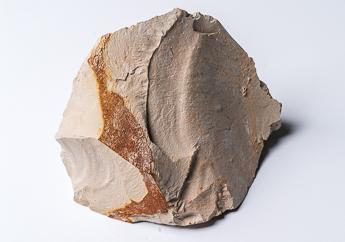Missouri Geological Survey Director: Carey Bridges, RG
The abundance of clay-rich sedimentary rock, known as fireclay, enabled 19th century brick makers in St. Louis, Mexico, Fulton and other regions of Missouri to manufacture large quantities of brick and firebrick for worldwide use.

Fireclay is a clay-rich sedimentary rock that contains a high percentage of aluminum oxide, which makes it very resistant to the effects of high temperatures. It is usually massive (not laminated or layered) and fractures into blocky or irregular fragments. Common colors include buff, yellow, red, green or brown. However, good, useable fireclay is usually white, cream-colored, gray, or almost black.
The four types of fireclay (each progressively higher in aluminum oxide or alumina content) are:
- Plastic clay – soft and, when wet, has the characteristics of a modeling clay.
- Flint clay – compact, smooth, and usually gray, tan or white in color. It will not slake or “dissolve” in water like plastic clay.
- Burley clay – similar to flint clay but contains many small, hard, pod-like “burls” which are concentrations of alumina. These burls are hard enough to scratch glass.
- Diaspore clay – the richest in alumina and is commonly buff colored, earthy and coarse, with burls concentrated in a porous matrix. It is very rough to the touch.
The abundance of clay-rich sedimentary rock, known as fireclay, enabled 19th century brick makers in St. Louis, Mexico, Fulton and other regions of Missouri to manufacture large quantities of brick and firebrick for worldwide use. Most Missouri fireclays can withstand being heated to temperatures greater than 3000° F without melting. Refractory products made from fireclay are of vital importance to the steel industry as linings in blast furnaces, kilns, fireboxes, fireplaces and to the space program for missile platforms or launching pads. Fireclay is also used as an additive in the manufacture of cement. It reacts with calcium hydroxide as concrete hardens and forms compounds that have the properties of cement.
Visit the department’s Ed Clark Museum of Missouri Geology, where you will find fireclay on display.
Nothing in this document may be used to implement any enforcement action or levy any penalty unless promulgated by rule under chapter 536 or authorized by statute.
For more information
Geological Survey Program
Missouri Geological Survey
P.O. Box 250
Rolla, MO 65402-0250
United States
